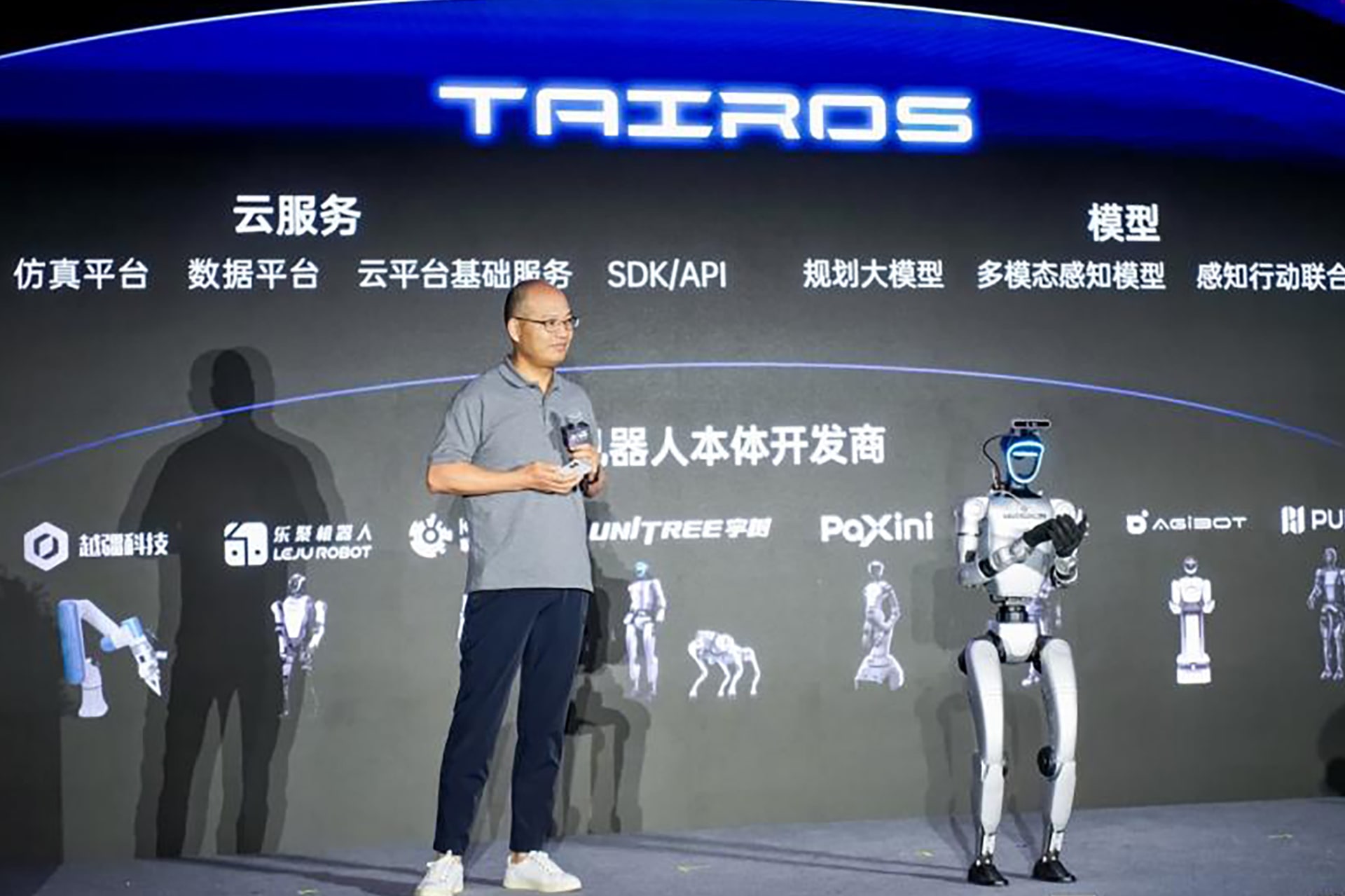Header photo source: JD.com.
Embodied artificial intelligence was arguably the centerpiece of this year’s World Artificial Intelligence Conference (WAIC), held in Shanghai from July 26–28.
Unlike last year’s edition, which featured 18 humanoid robots, this year’s event showcased more than 90 models, offering a broad display of both form and function.
The guest lineup reflected the momentum. Sergey Levine, co-founder of US-based robotics startup Physical Intelligence, appeared at Agibot’s forum. Even more notably, a rare panel brought together four prominent voices in embodied AI: Wu Yi, Gao Yang, Xu Huazhe, and Chen Jianyu.
China’s internet giants are also entering the space, eager not to be left behind. Tencent persuaded Zhang Zhengyou, head of its Robotics X lab, to make a rare public appearance. Zhang, a distinguished scientist and the highest-ranking technologist in Tencent’s history, has led Robotics X from the start and is known for a widely adopted machine vision calibration method.
Speaking at Tencent’s WAIC forum, Zhang emphasized the company’s positioning: “Tencent wants to be a partner to robot manufacturers.”

JD.com, which had remained mostly quiet during the large model wave, also signaled a shift. Around the time of WAIC, it launched a new corporate AI brand, JoyAI, and announced five investments in embodied intelligence startups over just three months.
According to 36Kr, JD has been actively branding these investments. Companies that received funding were reportedly asked to make JD’s involvement explicit. “[JD] insisted we include it in the title of the press release,” said an exec from one startup that recently secured funding from JD.
At WAIC, both Tencent and JD outlined their strategies for embodied intelligence. Notably, neither plans to build robots. Instead, they are positioning themselves as infrastructure providers, integrating their software and cloud capabilities into robotic platforms. Their bet centers on models and computing power as core pillars.
It could prove to be a smart play.
As large models fuel growth in cloud-based AI computing, cloud clients have become a competitive asset for hyperscalers. Embodied intelligence, still early in its commercial journey, presents a fresh opportunity.
In this pre-boom phase, providing backend systems is faster to commercialize and more scalable than building hardware. Regardless of how the robotics race unfolds, demand for compute and models from robot makers is set to remain strong.
With Tencent and JD moving early, competition for embodied intelligence clients is already underway.
JD, in particular, isn’t content to remain a retail channel. It aims to embed itself in the R&D process. Its entry point: helping robot makers enhance human-machine interaction through tailored model services.
He Xiaodong, deputy director of JD Explore Academy, told 36Kr that many robotics companies excel at control and locomotion but lack expertise in large language models (LLMs), speech technologies, and conversational agents. Yet from a user perspective, functionality isn’t enough as people want “robots that understand me.”
To meet that need, JD introduced the concept of “embedded intelligence” and launched the JoyInside platform. Its aim is to provide robots with conversational and emotional intelligence powered by large models, trained on both general and JD-specific data.
JoyInside’s tech stack runs on JD Cloud and includes smart computing infrastructure with retrieval-augmented generation (RAG), text-to-speech (TTS), automatic speech recognition (ASR), and LLMs, bundled into a multimodal, plug-and-play system for enterprise clients.
The platform also supports features like proactive dialog, emotion recognition, and long-term memory.
JD said the system has already been deployed by more than a dozen robot manufacturers.
Fuzozo, for instance, has used JD’s JoyAI foundation model to enable emotional responsiveness and consistent behavior in its toys, earning them the nickname “the AI version of Labubu.”
At WAIC 2025, JD hosted a showcase of its robotics partners, including Fuzozo, educational robot maker SenseRobot, and embodied AI firms EngineAI, Deep Robotics, and MagicLab.
Beyond model support, JD also offers retail channels. Robopoet founder Sun Zhaozhi told 36Kr that Fuzozo’s launch on JD received substantial platform backing. JD’s internal data supports this: during the 618 shopping festival, its smart robot sales tripled year-on-year, while sales of embodied AI robots rose 17-fold.
Tencent, meanwhile, hasn’t entirely stepped away from hardware. Since launching Robotics X seven years ago, it has developed a balancing bike (2018), a leg-wheel hybrid quadruped robot (2021), the TRX-Hand (2023), and an elder care robot (2024).
Its commercial focus is on software.
At WAIC, Tencent unveiled its Tairos embodied AI platform, designed to provide robot manufacturers and developers with modular tools.
According to Zhang, Tairos comprises two main components: model algorithms and cloud services. Its model framework, SLAP3, includes three classes of foundation models:
- Planning models help robots break complex tasks into steps.
- Perception models interpret the environment and internal states.
- Perception-action models convert sensory input into actions.
On the cloud side, Tairos supports simulation, training, and data management. Developers can access it via SDKs or APIs.
Tencent’s approach stems from observed challenges in the field: many startups lack the compute capacity for model training, and supervised fine-tuning is costly and difficult to scale. A neutral, integrated platform like Tairos aims to bridge those gaps.
Asked about Tencent’s investment role, Zhang clarified that he doesn’t handle deals directly but sees investment as a way to “grow the ecosystem.”
Tairos is intentionally modular. “If a company already excels at perception, they can just use Tencent’s planning or action models,” Zhang said.
Still, 36Kr reported that some companies prefer unified vision-language-action (VLA) models, now common in the industry. Modular platforms may thus not appeal to all.
Zhang acknowledged this: “Robotics companies that can build their own end-to-end model are not our target customers.”
To maintain neutrality, he emphasized that Tairos is not intended as a profit engine. “Our goal is to grow the robotics industry as fast as possible,” he said.
KrASIA Connection features translated and adapted content that was originally published by 36Kr. This article was written by Qiu Xiaofen and Wang Fangyu for 36Kr.
